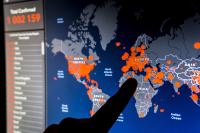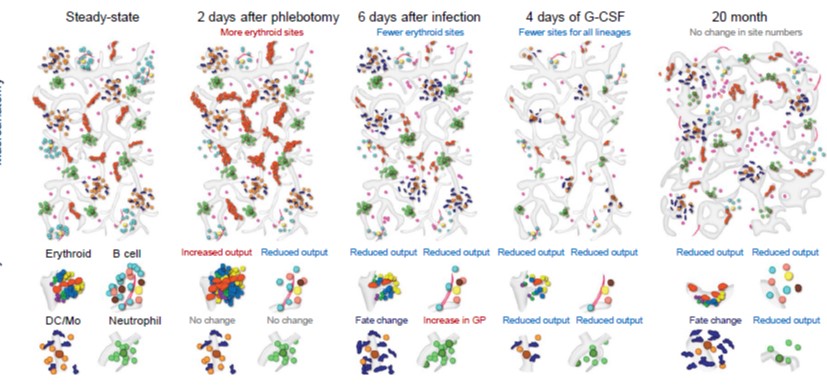Coronavirus: The Tip of the Iceberg for Climate Change Consequences?
Post Date: April 22, 2020 | Publish Date:

Editor’s Note: This perspective piece was co-authored by Louis Muglia, MD, PhD, former Co-Director of the Perinatal Institute and Director of Human Genetics at Cincinnati Children’s; now President and CEO of the Burroughs Wellcome Fund.
In celebration of the 50th anniversary of Earth Day…
Coronavirus has shut down the global economy and reduced employment with tragic efficiency. Even as epidemiologists see the echo of the 1918-1919 pandemic influenza epidemic, economists invoke the Great Depression as their referent for current trends. Moving quickly and lethally through the global population, the SARS-CoV-2 virus and its attendant COVID-19 disease are playing out in Asia, Europe, and North America now, with the rest of the Americas and Africa to follow in a matter of weeks.
For decades, we have seen a steady stream of viruses and other microorganisms that are transferred from vertebrate animals to humans (zoonotic diseases). Humans who inhabit expanding geographies on one hand, as the Amazon rainforest, or are driven to migration, as with the desertification of the Sahel, face disease-permissive climates and destruction of natural regulatory barriers, facilitating global spread of infection in the context of urbanization and overcrowding. HIV is one such virus that leapt into humans in rural central Africa and then spread worldwide to kill 33 million persons from AIDS in just four decades. Pandemics (epidemics that expand across continents) are facilitated by the fact that 95% of the human race can visit one another within 48 hours travel time.
Loss of biodiversity, a failure to meet unmet contraception needs, emerging infectious diseases, and climate change impact on health are all interrelated. When the Himalayan glaciers melt and its snowfalls are climatologically distorted, work of data scientists* predict alternating floods and droughts in the Indus, Ganges, Brahmaputra, and Mekong river basins, home to over 1 billion persons. Coronavirus is simply one manifestation of what will be a long string of adverse health and economic consequences of global warming, population pressures, and loss of species diversity.
How will we mitigate current trends in climate deterioration and together save this planet? The root causes of climate are well beyond the biomedical sector that now attends urgently to COVID-19. Broad multidisciplinary efforts, including public policy and political sciences, are needed for renewable energy, pollution control, water to drink and to irrigate, hygiene and sanitation, meeting women’s expressed desires to space the births of their children, and preservation of natural spaces whether oceans, forests, or lakes. Public and private commitments will be essential to mandate clean energy sources, use carbon more wisely – for example, virtual meetings and conferences as we are now conducting –, develop more bio-sustainable modes of food consumption, and devise technologies to remediate pollutant effects on the environment.
Since World War II, the globe has witnessed an unrelenting juggernaut of human population growth and attendant consumption. In the mid-1950’s, 2.5 billion persons inhabited the planet. Today, each of us is among 7.7 billion fellow human beings, and by 2050 that number is expected to grow further to 9.7 billion. The human core need and excessive appetite for resource and energy consumption have fundamentally changed the biosphere, resulting in dangerous pollution and greenhouse gas levels from human transportation, agriculture, and industrial activity. Humans are encroaching pristine forests and natural spaces by sheer force of numbers and in the hunt for more resources.
Crowding of humans into wild spaces will bring more zoonotic diseases. Expanded habitats for insects that thrive in warmer weather will bring arboviral (“arthropod-borne”) and parasitic diseases like malaria. Our business and policy communities, our scientists and public health professionals, and our citizen advocates must address climate change and must embrace pandemic preparedness to prevent future and potentially even more disastrous threats.
Both human health and global economic welfare are threatened by severe weather, destruction of global reef and fish ecosystems, loss or degradation of lakes and forests, expansion of deserts, loss of sea and land ice, toxins in our air and water, and expanded mosquito- and tick-borne diseases with warming environments. Health and economics are threatened by climate change on a scale dwarfing COVID-19, but coronavirus gives us our fair warning.
We think of coronavirus as an existential threat, given its risk to the elderly, vulnerable, and many others. Imagine this as a recurring theme, added to crisis in fisheries (oceans and lakes) and land use (agriculture and forests), including water shortages (surface and ground waters). It is urgent that we elevate the importance of environmental and health sciences in STEM education (Science, Technology, Engineering, and Mathematics) to nurture creativity to find solutions to sequester carbon, bring renewable energy to scale, and enhance pandemic preparedness and surveillance in ways that have yet to be envisioned. The magnitude of investment and urban reorganization needed exceed any single or group of philanthropists or scientific organizations, but partnerships with governments can support research and deployment investments commensurate with urgent global needs.






